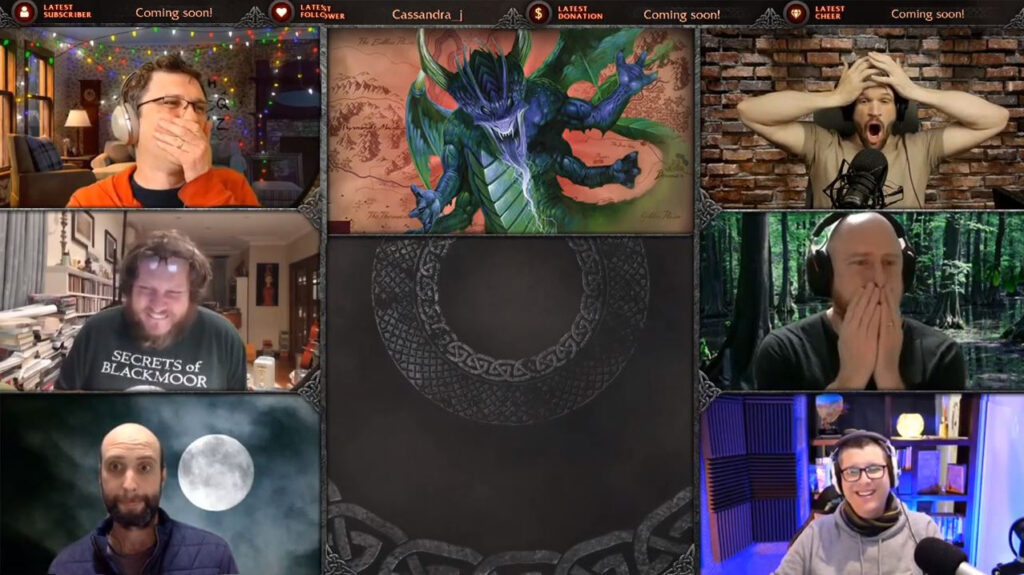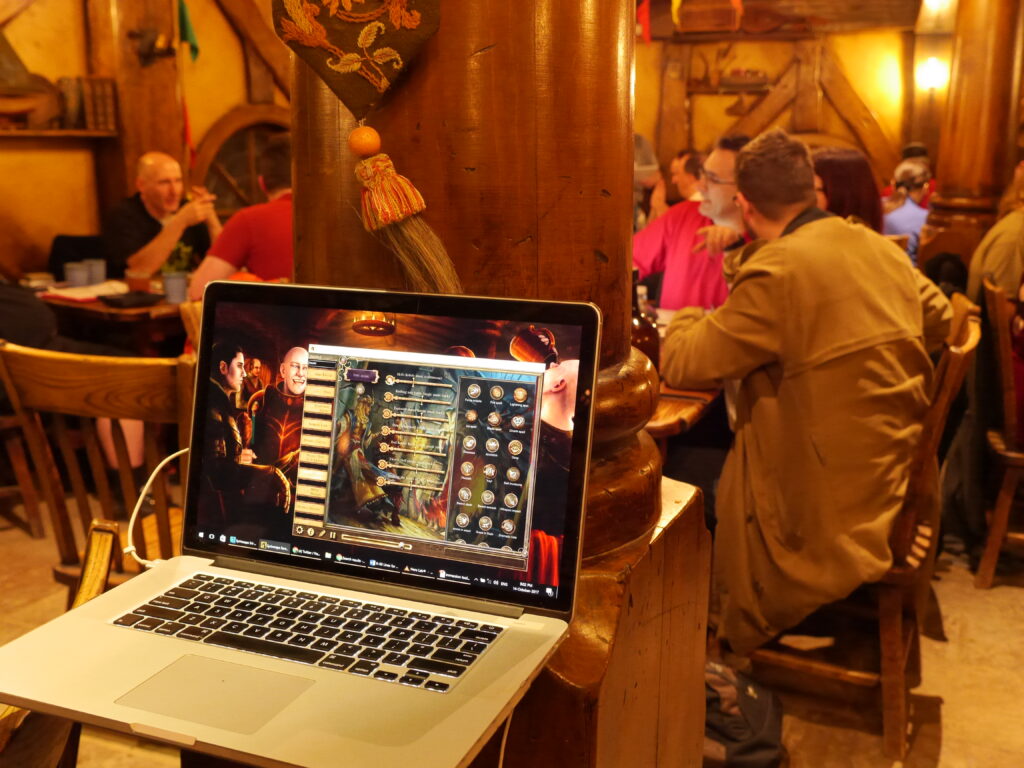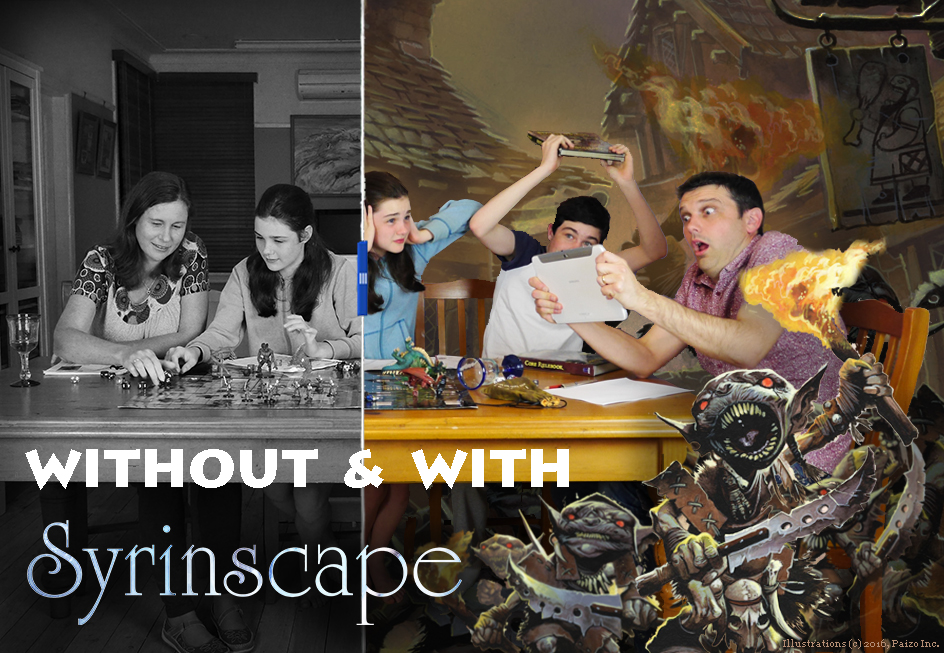The Best Fluffy Pancakes recipe you will fall in love with. Full of tips and tricks to help you make the best pancakes.
How to Be a Better Dungeon Master Through Improvisation
Here’s one of the best Dungeon Master tips I ever received. Tabletop RPG advice worth repeating, in my humble opinion, but maybe I am wrong. Whether you agree or disagree, jump into the comments section at the bottom to give us your take. When it comes to Tabletop RPG advice, one of the most valuable tips I’ve learned is to say ‘Yes’ to player ideas. This approach not only keeps your Dungeons & Dragons roleplay alive and dynamic, but it is also a powerful driver of collaboration and creativity at the table.

When we play Dungeons & Dragons, or Pathfinder, or Call of Cthulhu or one of the many other tabletop roleplaying games (TTRPGs), what are we doing? It’s there in the name. We come to the table to play roles. We are playing characters, and what do characters inhabit? Stories! For me at their core, these games are about storytelling. We are familiar with story tellers as solo artists, musicians, authors etc, but what is very very special about TTRPGs is that, in these games, the story is not just ONE person’s story, but everyone’s story. Sure, the Dungeon Master plans out the most probable overall story arc and has various plot points they are aiming to hit, but it is, in fact, up to EVERY player at the table to push or pull, lead, and sometimes even divert that story from its intended path. As such, we Dungeon Masters (DMs or Game Masters) must be adaptable. Faced with a storytelling contribution from a player that doesn’t fit perfectly within the plan we HAD (boldly) planned, we have two choices: reject the idea, possibly disenfranchising the player, or find a way of saying “Yes”, adapting our plan and incorporating that player’s ideas.
Picture This: You’re at the table with your friends, the air is thick with anticipation. You (the DM) have a plan. You know which way the adventure is going to go. You’ve statted-out monsters, NPCs with solid descriptions, maps, minis and everything else ready. Partway into the evening’s play, you see that peculiar glint in one of your player’s sparkling eyes—they’ve got a wild, cinematic idea that’s so ‘out there’, it just might work. It’s an idea that makes the rest of the players’ eyes light up too, and elicits a few “oooo”s and “aaaah”s. This idea might, however, cheat you out of your plans, head the adventure off in a whole direction you never planned. Hmmm…
What do you do in this situation? I say embrace the new idea. Just say, “Yes!” Sure, you can toss in a twist with a “Yes… but!” or a dramatic “Yes… and!” Even a cautious “Yes… and are you really, really sure?” But the point is, open the door to the possibility your player might have just had the most awesome idea ever.
Do this and the player will feel amazing for having their idea recognised as worth including. They might even become more invested in the story you were trying to tell. Very possibly, the way the (overall) plot is heading will now make even more sense to them, and they will become even more likely to contribute more in the future.
Improvisation Techniques for D&D – The “Just Say Yes” Approach
So when you encounter this situation, what are some of your options, specifically? Here are a few improvisation techniques for D&D to help you move forward, once the table is finished “ooOOOooo”ing, of course. These tabletop gaming strategies can truly make your RPG storytelling dynamic and engaging.
Step number one, DON’T make the player roll dice. This is the part I most passionately believe in. When a player pitches a stunt that screams epic? Drop a “Yes” bomb right on it. If their idea doesn’t necessarily derail your story, let it ride the rails directly to glory. No dice roll needed—if it’s cool, it works. Seriously, do NOT make them roll. For me, there is nothing quite so painful as everyone at the table thinking an idea is brilliant and then having the dice nix the cool. Just move straight onto step two.
Step number two, decide what SORT of “Yes” you are giving. Here are a few options:
- “Yes” with a Side Serve of Consequence: Sometimes, a “Yes” needs seasoning. “Yes… but!” might add a dash of spice, a challenge (yes, a dice roll) to sweeten the victory, or maybe a complication to set the stage for future adventures. This can be useful if your players are needing a reminder that they can’t just bypass every challenge you set with something simple and silly.
- “Yes that fits just perfectly”: “Yes… and”, your players don’t know everything about the story you have planned, so don’t expect them to guess perfectly right every time. Often you can take a player’s idea that is great and make it perfect for them AND your story. Sometimes with a little twist you can actually help their idea HELP your story. “Yes, and THAT’S how the party ended up in jail.” “Yes, and even more incredibly, the mayor was your uncle all along.”
- “Yes”, when “Yes” is a Genius-Player-Driven Plot Twist: I love few things more than when I have set up a whole lot of clues which I THOUGHT led somewhere fairly obvious, and suddenly a player’s eyes light up and they cry, “Oh. My. God..! X is actually X’s X and has been hiding it the whole time?!?! Right?!?!?!” Even though that was NEVER my idea in the first place, if their interpretation actually makes more sense than what I HAD planned, it probably IS something that leads more logically on from where everyone has found themselves. Not only will the story be better, but the players will be patting themselves on the back for working out YOUR dastardly plan for ages! Even though it was really THEIR dastardly plan… they don’t know that, right?
- “Yes” that’s actually “No”, acknowledging the idea: “Yes, that’s a great idea” and moving on to something even better (or darker) “What a great idea… but in fact… Nooooo!”. If you say yes often enough to your players, if they trust that you will take their ideas seriously, that you respect and appreciate their creativity and engagement, THIS is actually the thing that allows you to say “No” when it REALLY matters. If your players know you only say “No” when you are quite sure that the ACTUAL story (your story) is even MORE brilliant (or scary) (or hilarious) (and/or logical), and if you say, “No” with just the right mysterious twinkle in your eyes, then these are the “No”s that will make your players lean forward and try even harder to work out just-what-is-going-on.
Best Game Master Tips for Storytelling and Player Engagement
- Encouraging Player Creativity Without Losing Control
When you’ve built respect and trust at your table, your players will be keen to blend their ideas usefully into the story as everyone currently understands it. In my humble opinion, this is one of the best Dungeon Master tips for fostering RPG storytelling that feels truly collaborative and immersive. Everyone will be working to build on the foundation laid before them, ultimately weaving a tale richer than any pre-written script could be.
- Handling Unexpected Scenarios and Unpredictable Choices
When a player’s idea cuts across your plans sharply, still say “yes”, but give your chosen player-storyteller a few parameters and then let them improvise within a safe usable boundary. Especially if you will be needing to frantically rework some of your notes, this can help to give you the moments you need. Let the player know, “Yes, you have correctly deduced that the Duke is in fact your rogue’s uncle” (their idea). “It has been in fact HIM all along that has been plotting to murder the cleric”, (this much was already a part of your plan).”What’s more”, (taking this player aside), “you also discover distinct clues that the Duke is actually a vampire in disguise” (the whole idea of the campaign). “Have a think and then tell everyone two things. What was the evidence that clinched this for you? Describe how you found it. What is it? How does your character break it to the party, and in particular, to the rogue…”
- Keeping Narrative Consistency While Improvising
Keeping control of the degree of freedom, can help player contributions add to the story rather than derail it. When your players are ‘on board’ with your vision of the story, when they understand you have some great ideas AND are willing to incorporate theirs, they will be happy to have their ideas corralled, (i.e. limited and adjusted as necessary to help rather than hinder the story that everyone is telling). Players know you are the only one with a (semi)complete overview of everything that is going on, and they are most likely ready and keen to help your best (and worst) plans come to pass. And what’s best of all, they will never know, JUST how much they have contributed to what has seemed to be an incredibly coherent and brilliant web of events.
How to Create Immersive RPG Experiences Through Improvisation
So, I just claimed that you, as the DM, have the best overall view of the plot, but who understands the player character’s backstory and motivations and points of view the best? It’s the players, of course. This is where improvisation in RPGs really starts to shine. By weaving your players’ ideas and perspectives into the story, you can create immersive RPG experiences that feel personal and engaging. Players may have shared many details of their back story with the you a long time ago, but much of this may be long forgotten, so when a seriously obvious chance comes to weave player character backstory into the main plot, you’ll need players who know that speaking up with an idea is worth it.
Imagine this: Suddenly the player of the Wizard announces, “Oh gods, this is the same hand writing. THIS is the same sage who wrote the book my wizard read all those years ago. The one that set him on the path of the arcane in the very beginning.” You of course respond, “Yes!”
“…and how does your character react? The sage is disappearing up the alley already. You’ll have to be quick.”
When a player’s backstory is weaved into the plot, this can become a huge moment of immersion for them. Suddenly the player feels like the story is about THEM. Somehow everything that has happened adds up and now makes sense.
So how do you create these opportunities? Details, that’s what. Describe the handwriting they are reading (as above), the architecture of the tavern, the accent of the barkeep, the things on sale at the market, the smell of the spices in the meat and mead, the fighting style of the young prince. Every little detail you include provides a potential hook for your players’ ideas, and an opportunity for them to get in-on-the-tale.
I will write an individual blog post about practicing description as a Dungeon Master, but the super short essential hint is: think and describe with ALL your senses. Let your players know: what does it look like, what does it smell like, what do your players hear, what does it feel like under their boots or how does the weather make their clothing feel, what taste is in their mouth? Practice describing scenes or NPCs like this, in blocks of at least 60 seconds.
Using Sound Effects in Tabletop RPGs to Reinforce Improvisation
Of course all this engagement in the story, and receptiveness depends on your players being focused on the table, and since this is a blog post on Syrinscape’s website, I’ll mention the number one tool I use to enhance Dungeons & Dragons roleplay: music and sound = just one of the important tabletop gaming strategies I use to help create immersive RPG experiences that keep players hooked.
(play this while you read on)
See my “Psychology of Audio in Tabletop Gaming” article for all the detailed ins and outs of this subject, but the main point is… really good music and sound help to immerse your players in the story and help to keep their focus at the table on each other. The right sound and music at the gaming table help your players to feel the things their characters will be feeling, and that’s the most important component relevant to this blog. The more your players are feeling in-the-shoes of their characters, the more they will be listening to your descriptions as if they were their actual characters and the more they will be noticing details that fit into their character’s story as well.

Imaging this scenario: a player has described their character as “being afraid of wolves” (quite a few weeks ago during Session 0). Tonight, the player hears a random wolf howl played back by Syrinscape as a part of the “Witchwood” SoundSet (free to try with Syrinscape without even needing to make an account).
Suddenly they pipe up, “A wolf! Can my fighter just completely freak out and ‘leg it’ into the forest?!” Now, secretly you’ve been wanting all along for the party to be captured by the elves who haunt these woods, but as all DMs know, actually subduing a party without killing them can be a tricky thing. Thinking fast, “Yes”, you announce, “You know what… I’d love the rest of the party to leg it after them. It would be amazing if everyone somehow ends up in a pit trap, or one of those nets like in Return of the Jedi. Can someone tell us a story about how all that turns out?” Doing this, the fighter’s player gets to hog a chunk of limelight, backstory is incorporated and reiterated and reinforced, a highly colorful sequence of events plays out, presumably there’s some really fun intercharacter banter/recriminations… AND you get the party into the clutches of the elves, just where the story needs them. All THAT from a group of focused players and a random sound from Syrinscape.
This reminds me of one of my favourite moments at my own table. I had my player characters gazing down a hole in the floor to a lower dungeon level, a level I did NOT want them to explore yet (all the monsters were way-overpowering-for-them right then). I had the Dungeon Depths SoundSet playing (another SoundSet that comes free with Syrinscape). At just that moment, Syrinscape’s randomized audio machine chose to play a dark, distant, deep and powerfully-scary roar.
Nathan’s character says, “I go back to town to become a florist.” It was a passing joke, but we turned it into more. I said, “Yes, in fact I kinda need you all to NOT go down that hole yet. Someone tell me why you go upstairs instead. Maybe Nathan’s character just walks back outside right now. Does everyone have to follow him? Does an argument ensue?” Engaged, focused characters, listening intently not ONLY to my highly descriptive Dungeon Mastering, but also plugged into the sound and music that was filling our game room with frankly somewhat TOO intensely immersive ambiance, made for one of our most fond gaming memories.
How to Engage Players in Dungeons & Dragons with Adaptive Storytelling
So, yes, immerse your players with great descriptive language, fill the gaming room with rich sound and music, and say “Yes” to the ideas that flow out of invested players. The more you say “Yes”, the more great ideas your players will bring to the story you are all endeavoring to tell together.
Contract with your players that you will say “Yes” as often as possible, as long as they commit to: be flexible, not take advantage of the opportunity, work to progress the story, and be prepared to take a “No” sometimes as well.
Tips for Running a Flexible D&D Campaign Without Losing Control
And one final thing… someone has hopefully already pointed out in the comments (without having read this far), “saying yes to your players all the time makes them invincible. Players will always ask for too much. They will swing the power curve so much in their OWN favour that the game won’t be fun for the DM any more.” I, in fact, have found quite the opposite. If you give your players enough ‘free shots’ from their good ideas, before too long, you’ll be able to rely on them to come up with their character’s trials and tribulations AS WELL. Yes, good stories aren’t just made up of the lead characters winning easily all the time, and if it’s clear EVERYONE is responsible for creating the best story possible, pretty soon your players will be on board crafting an epic legend with you, with a good dose of trials and tragedies and mishaps built in.
If you begin to feel your players are taking too much ‘advantage’ of your narrative generosity, talk to them. Let them know you are loving their ideas, and remind them that they hold a responsibility for telling the best possible stories as well. It’s not just YOUR job to challenge the characters, in fact, your players know so much more about their characters, they probably: know just-the-right-buttons to push, they know how to compromise their characters, how to tempt their characters, and how to force them right to the edge of failing.
Mastering the Art of “Yes” in Role-Playing
If you can use the power of “yes” just right at your table, and of course wield the other important immersion tools well: sound and music (seriously try out Syrinscape), lighting, tea-stained handouts, great maps, beautifully painted minis, then when your players look back on their quests, they won’t just recall the dragons they slew or the dungeons they plundered. They’ll remember how your Game Master skills and masterful RPG storytelling worked together with their fantastic character-play to transform a mere game into a true adventure.

So, Dungeon Masters, next session, lean in, listen, and liberally lace your responses with “Yes.” Then, watch as your tabletop tales grow into something truly transcendent. And when your players tell stories of their escapades, they’ll know… That campaign? It was legendary, in no small part because our DM said… ‘Yes”.




